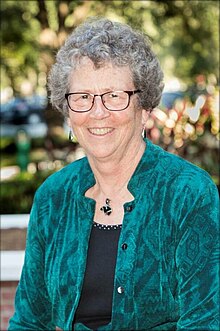Loading AI tools
American marine biologist From Wikipedia, the free encyclopedia
Pamela Hallock Muller is a scientist, oceanographer and professor at the University of South Florida in the College of Marine Science.[1]
Pamela Hallock | |
|---|---|
 Pamela Hallock (2018) | |
| Born | Pamela Mary Hallock June 2, 1948 Pierre, South Dakota, U.S. |
| Nationality | American |
| Alma mater | |
| Scientific career | |
| Fields | Oceanography |
| Institutions | University of South Florida |
Hallock Muller's research has focused on reef-associated Foraminifera and algal symbiosis, extending into coral-reef ecology, paleobiology and carbonate sedimentology.
She has worked as a diversity and inclusion advocate who has promoted gender equality within academia and marine science.[2][3][4]
Hallock Muller was born in 1948 on a small ranch on the Rosebud Reservation in south-central South Dakota, Pamela Hallock attended elementary school in a one-room schoolhouse and started high school in Mission before her family moved to Missoula, Montana in 1963, where she completed high school.
She received her Bachelor's degree in zoology from the University of Montana, Missoula in 1969,[5] and married a fellow zoology major, Robert Muller, in summer 1969. She received her Master's and Ph.D. degrees in oceanography from the University of Hawaii in 1972 and 1977.[6]
She has spoken on the discrimination that she faced as a young woman in academia. [7]
Pamela Hallock Muller started as an assistant professor at the University of Texas of the Permian Basin in Odessa, TX, in 1978.[8] She then moved to the University of South Florida as an associate professor in 1983 where she became a full professor in 1988.[9]
Hallock Muller uses field studies to understand the role of nutrients, light and ocean chemistry in coral reefs, carbonate sedimentology and paleoceanography. She has studied algal symbiosis in the context of carbonate production, community structure and evolution of coral reefs.
A key aspect of her research is the study of reef-associated Foraminifera, including distributions, population dynamics and functional morphologies, with applications in studies of environmental quality, paleoenvironments, carbonate sedimentation, and global environmental change.[10]
Her 1986 paper in PALAIOS with colleague Wolfgang Schlager-”Nutrient excess in the demise of coral reefs and carbonate platforms”-was named one the “Landmark Papers in Carbonate Sedimentology and Stratigraphy” by the American Association of Petroleum Geologists 100th Anniversary Committee in 2017.
She participated in a 10-day saturation mission in the NOAA-National Undersea Research Center's Aquarius Habitat in 1994.[11] She also participated in the International Ocean Discovery Program's Leg 194 in 2001.[12][13]
When not working, Dr Hallock Muller enjoys scuba diving, kayaking, and traveling. She also volunteers as a member of ARCS Tampa Bay since 2011, a science judge for the Spoonbill Regional National Ocean Sciences Bowl, a judge for local, regional, and state science fairs in Florida, and with the Pinellas Coastal Cleanup.[24]
Seamless Wikipedia browsing. On steroids.
Every time you click a link to Wikipedia, Wiktionary or Wikiquote in your browser's search results, it will show the modern Wikiwand interface.
Wikiwand extension is a five stars, simple, with minimum permission required to keep your browsing private, safe and transparent.